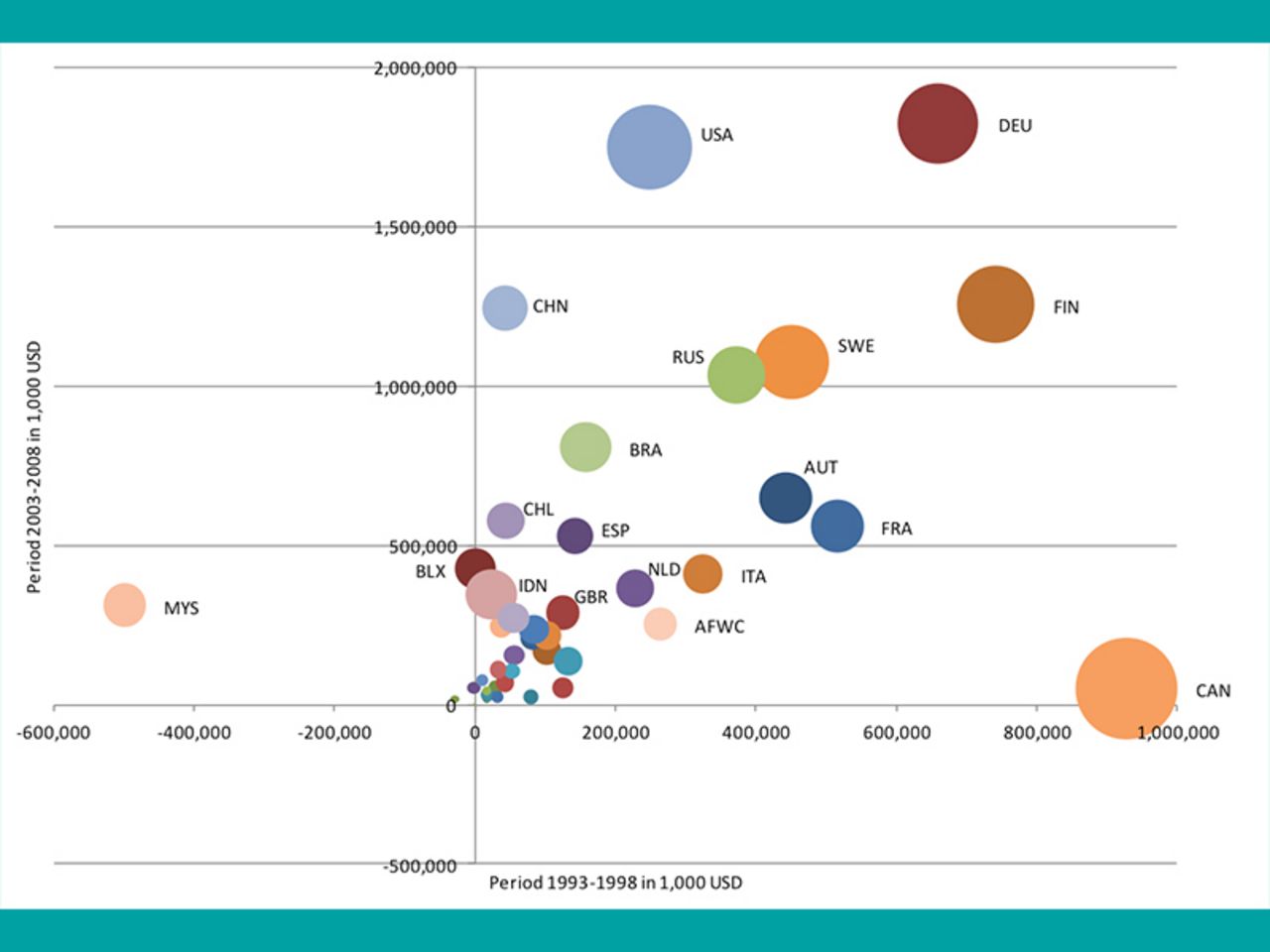Project
The forest industry in competition

Analysis of the competitiveness of German forestry and the diverse branches of the forest products industry
The German forest based sector is one of the major global exporters of wood and paper products. Will the sector be able to holds its position in future?
Background and Objective
The forest based industry sector is a relevant part of the national economy in Germany. We regularly analyse international developments in order to fathom out if the competitive situation of the German forest sector has changed. The analyses help to contribute in the continuous policy consultancy process.
Approach
International trade theory provides various approaches to measure competitiveness. These can be classified into two groups: Result-oriented indicators (ex-post perspective) and determinant-oriented indicators (ex-ante perspective). Result-orientated indicators reveal competitiveness on base of market data of the past. Determinant-orientated indicators are based on the assumption of a correlation between determinants and the competitive situation of a country.
Results
The development of market shares in the forest based products market show an increasing import penetration of domestic markets, particularly in the sectors near to finished products, and at the same time there is an increasing export orientation of domestic production. In the field of paper production a growing international integration and specialization can be seen: more than 60 % of the products that are available on the domestic market originate from imports, and at the same time 60 % of domestic production is sold on foreign markets.
International trade analysis of forest based products was analyzed using the method of constant market share (CMS) analysis. The analysis was conducted based on bilateral trade data in monetary terms. CMS analysis is carried out on two aggregation levels: the forest industry sector on the whole and the manufacture of wood as part of the semi-finished products sector, covering forestry, manufacture of wood and furniture and pulp, paper, paperboard and products of them. The analyses of both aggregation levels show similar results. Most of the traditionally industrialized countries show only low export growth rates and low competitiveness effects. Countries with fast growing economies in general, in particular those from South East Asia and most of the Eastern European countries show high growth rates as well as high positive competitiveness effects.
As an exception from the above findings Sweden and Germany amongst the industrialized countries show export growth rates of around 10 % each. For Sweden we found that an extreme windthrow incident in 2005 connected with boosting sawnwood exports as well as an exceptionally low base level of the reported export figures in the starting year of our analysis 2000 can explain the phenomenon. Moreover, the effect proves to be constant when extending the analyzed period. With regard to the German forest based industry sector we pointed out that all analyzed compartments of the sector contribute to the above mentioned observation. However constant-market-share-analysis is not able to provide a causal explanation for the findings.
As part of the second European Forest Sector Outlook Study (EFSOS II) – under the of the UNECE/FAO Forestry and Timber Section – we hold responsible for the analysis of the historic and future competitiveness of the European Forest Sector using the constant market share (CMS) methodology. The results of the reference scenario show that the world market will constantly increase in period 2010 to 2030, with benefit also for the countries of the EFSOS region. However, the growth of the world market will be the only driver which leads to export growth in the EFSOS region. This means EFSOS countries are expected to be below world average with regard to their presence in expanding regional markets, in particular, for growing commodity markets and with regard to their competitiveness. For the detailed report on this analysis please look here.
Thünen-Contact

Publications
- 0
Dieter M, Janzen N (2015) Deutsches Cluster Forst und Holz im internationalen Wettbewerb. AFZ Der Wald 70(17):13-15
- 1
Weimar H, Englert H, Moiseyev A, Dieter M (2014) Competitiveness of the European Forest Sector - a contribution to EFSOS II. Geneva: UNECE/FAO Timber Section, 80 p, Geneva Timber Forest Discuss Paper 62
- 2
Dieter M, Seintsch B (2012) Änderung der Wettbewerbsfähigkeit der Holz- und Papierwirtschaft in Deutschland auf Grund zunehmender Knappheit an Nadelholz. Allg Forst Jagdzeitg 183(5/6):116-128
- 3
Dieter M, Englert H (2009) Zur Wettbewerbsfähigkeit der europäischen Holzwirtschaft - eine Constant-Market-Share-Analyse. Schweiz Z Forstwesen 160(12):375-383, DOI:10.3188/szf.2009.0375
- 4
Dieter M, Englert H (2007) Competitiveness in the global forest industry sector: an empirical study with special emphasis on Germany. Eur J Forest Res 126(3):401-412



![[Translate to English:] Logo des Bundesministerium für Ernährung und Landwirtschaft](/media/allgemein/logos/BMEL_Logo.svg)